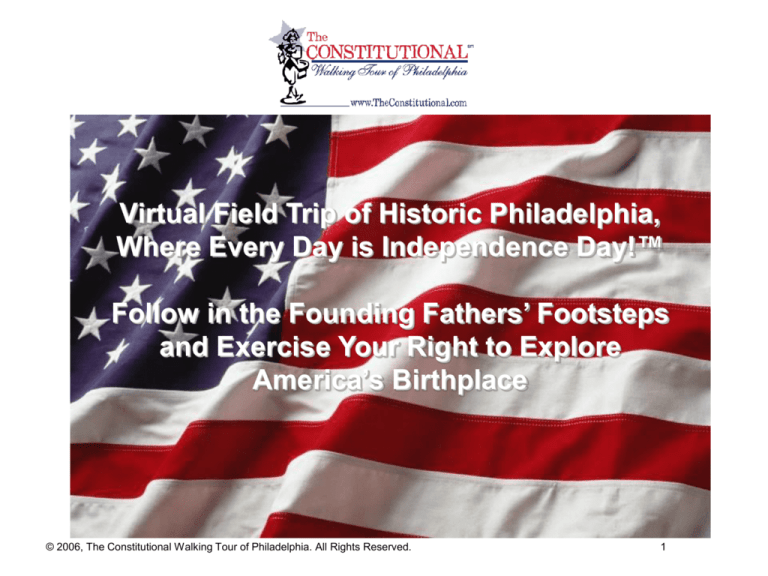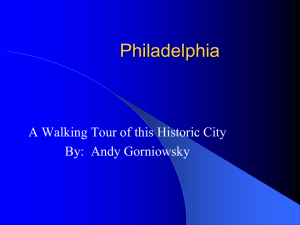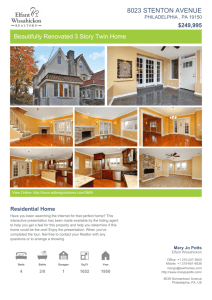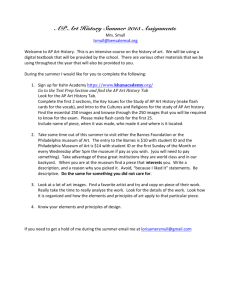
Virtual Field Trip of Historic Philadelphia,
Where Every Day is Independence Day!™
Follow in the Founding Fathers’ Footsteps
and Exercise Your Right to Explore
America’s Birthplace
© 2006, The Constitutional Walking Tour of Philadelphia. All Rights Reserved.
1
For those who cannot travel to Philadelphia, The Constitutional Walking Tour provides free
“Virtual Field Trips" so that you can "walk" in the Founding Fathers' footsteps and learn
about the birth pf America, including the creation of The Declaration of Independence and
The Constitution of the United States, by taking The Constitutional's tour online.
The Constitutional’s “virtual field trip” is a great way to celebrate Constitution Day!
Above, you’ll see some of the historical figures we’ll meet along our journey today.
© 2006, The Constitutional Walking Tour of Philadelphia. All Rights Reserved.
2
The Constitutional Walking Tour tells the
dramatic story of the brave men and women
who were responsible for creating America.
The rest is simply history…
Today, on this “virtual trip” to Historic
Philadelphia, you will follow in the Founding
Fathers' footsteps.
The Constitutional takes you on a journey
through America's Most Historic Square Mile the birthplace of our nation. Step back in time
to see where The Declaration of Independence
and The United States Constitution were
created.
Following our map, today you will “visit” more
than 30 historical sites including the Liberty
Bell, Independence Hall and the National
Constitution Center.
If you’re ready, let’s get started!
© 2006, The Constitutional Walking Tour of Philadelphia. All Rights Reserved.
3
Welcome to Philadelphia,
the City of Brotherly Love!
Philadelphia was founded
in 1682 by William Penn.
At that time, Philadelphia
was under British rule, and
it was the largest city in the
Colonies. Philadelphia
also served as the capital
for the United States from
1790 until 1800. Today,
Philadelphia is the 5th
largest city in the United
States, and the second
largest city on the East
Coast with a metropolitan
area population of
approximately 5.8 million
people.
© 2006, The Constitutional Walking Tour of Philadelphia. All Rights Reserved.
4
© 2006, The Constitutional Walking Tour of Philadelphia. All Rights Reserved.
5
Stop 1 - National Constitution Center
The National Constitution Center is the first museum in the world devoted to
dramatically telling the story of The United States Constitution from Revolutionary
times to the present through more than 100 interactive and multimedia exhibits, film,
photographs, text, sculpture and artifacts. Be sure to walk through Signers’ Hall with
its life-size statues including Benjamin Franklin and George Washington. Watch
Freedom Rising which brings to life the historical context of The Constitution and its
impact on our lives today. Take the Presidential Oath-of-Office and vote for your
favorite President of all-time.
© 2006, The Constitutional Walking Tour of Philadelphia. All Rights Reserved.
6
Stop 2 – Independence Visitor Center
Visitors to the Independence Visitor Center will discover a range of services and
amenities that provide a warm welcome and all of the information you need to plan
your visit to the Philadelphia area including Independence National Historical Park.
Get your free timed tour tickets for Independence Hall on the morning of your visit, on
a first-come, first-served basis. Throughout the day, you can watch two films:
Independence and Choosing Sides. Visit the Independence Store for souvenirs and
the Pennsylvania General Store Café for refreshments.
© 2006, The Constitutional Walking Tour of Philadelphia. All Rights Reserved.
7
Stop 3 – The Liberty Bell Center
As the official bell of the Pennsylvania State House, which is today called Independence
Hall, the Liberty Bell rang many times for public announcements. It may have rung on
July 8, 1776 to announce the first public reading of The Declaration of Independence.
The Liberty Bell, which weighs about 2,000 pounds, was silenced by a crack in 1846. Its
inscription reads: "Proclaim Liberty throughout all the Land unto all the Inhabitants
thereof" - Leviticus XXV, v.10, The Bible. The new Liberty Bell Center features exciting
exhibits on the history of this world-famous icon of freedom.
© 2006, The Constitutional Walking Tour of Philadelphia. All Rights Reserved.
8
Stop 4 - Independence Hall
Independence Hall, the birthplace of America, was built in 1732 as the Pennsylvania
State House. Within this hallowed hall, the Second Continental Congress met in May
1775, and The Declaration of Independence was adopted on July 4, 1776.
Independence Hall is also where the Constitutional Convention met to draft, debate
and then sign The United States Constitution on September 17, 1787 .
© 2006, The Constitutional Walking Tour of Philadelphia. All Rights Reserved.
9
Stop 5 – Congress Hall
Constructed between 1787 and 1789 as the Philadelphia County Court House,
Congress Hall served as the United States Capitol, the meeting place of the United
States Congress, from 1790 to 1800, when Philadelphia was the Capital of the United
States. The House of Representatives met on the main floor, while the Senate
assembled upstairs. From its earliest days the Senate thus came to be referred to as
the "upper chamber." Among the historic events that took place here were the
inaugurations of President George Washington (his second) and President John
Adams.
© 2006, The Constitutional Walking Tour of Philadelphia. All Rights Reserved.
10
Stop 6 – Old City Hall
The United States Supreme Court met here from 1791 until 1800 when the Capital of
the United States was moved from Philadelphia to Washington, D.C. Early members
of the Supreme Court included: John Jay, Chief Justice, 1789 to 1795 and Oliver
Ellsworth, Chief Justice, 1796 to 1800.
© 2006, The Constitutional Walking Tour of Philadelphia. All Rights Reserved.
11
Stop 7 – Philosophical Hall
The American Philosophical Society was founded in 1743 as a home for thinkers
about nature, machines, industry and governance. It was founded through the
outgrowth of an idea fostered by Benjamin Franklin, and it is the oldest learned
society in the United States. Today, the Society continues as an eminent scholarly
organization of world-wide reputation, renowned for its excellence in scholarly
research and publications, its library, its exhibitions and its international roster of
elected members who make up a veritable “Who’s Who” of outstanding individuals in
the arts, humanities and the sciences. The Museum in Philosophical Hall presents
exhibitions and programs based on the Society’s rich collection of art and artifacts.
The museum is free and open to the public.
© 2006, The Constitutional Walking Tour of Philadelphia. All Rights Reserved.
12
Stop 8 – Tomb of the Unknown Soldier
The Tomb of the Unknown Soldier lies within Washington Square, one of the five
public parks drawn up by William Penn in his 1682 blueprint for Philadelphia. In 1954,
the Washington Square Planning Committee decided to erect a memorial that
honored both George Washington and an unknown soldier from the Revolutionary
War.
© 2006, The Constitutional Walking Tour of Philadelphia. All Rights Reserved.
13
Stop 9 – Library Hall
The Library Company of Philadelphia, founded by Benjamin Franklin in 1731, was
housed on the site of Library Hall from 1790 to 1880; the Library Company served as
the Library of Congress from 1774 to 1800. In the 1880s, the Library Company
moved to 1314 Locust Street, and the original Library Hall was then demolished. In
the 1950s, a reproduction of Library Hall was constructed on its original site. Today,
Library Hall houses some of the American Philosophical Society’s collections, and the
Library Company still functions as a prominent research library on Locust Street.
© 2006, The Constitutional Walking Tour of Philadelphia. All Rights Reserved.
14
Stop 10 – Second Bank of the United States
Completed in 1824, the Second Bank of the United States is one of the finest
examples of Greek Revival architecture, modeled on the Parthenon in Greece. The
Second Bank was designed by William Strickland who was known as the "city
architect" because he created a large number of Philadelphia’s public buildings. The
Second Bank was incorporated in 1816, and it was one of the most influential
financial institutions in the world until 1832. Today, the building houses a collection of
late 18th and early 19th Century portraits.
© 2006, The Constitutional Walking Tour of Philadelphia. All Rights Reserved.
15
Stop 11 – Todd House
Built in 1775, the Todd House was occupied from 1791 to 1793 by lawyer John Todd,
and his wife Dolley Payne. Todd died during the 1793 yellow fever epidemic.
Following her husband’s death, Dolley married James Madison, who later became
the fourth President of the United States.
© 2006, The Constitutional Walking Tour of Philadelphia. All Rights Reserved.
16
Stop 12 – Bishop White House
The Reverend Dr. William White, rector of Christ Church and St. Peter’s Church as
well as the first Episcopal Bishop of Pennsylvania, lived in this house from the time it
was built in 1787 until his death in 1836.
© 2006, The Constitutional Walking Tour of Philadelphia. All Rights Reserved.
17
Stop 13 – Polish American Cultural Center Museum
The Polish American Cultural Center Museum features exhibits on Polish history and
culture, including a pictorial display of "Great Men and Women of Poland." Some of
the notable people featured in the exhibit from Colonial and Revolutionary times are
Thaddeus Kosciuszko, one of the 18th Century's greatest champions of American
and Polish freedom, and Casimir Pulaski, "Father of the American Cavalry."
© 2006, The Constitutional Walking Tour of Philadelphia. All Rights Reserved.
18
Stop 14 – Merchants’ Exchange
The Merchants’ Exchange, designed by William Strickland in 1831, is the oldest stock
exchange building in the United States. During President Andrew Jackson’s first term
in office, Philadelphia, along with the rest of America, was in the midst of an economic
boom, and the building was a hub for financial and commercial activities.
© 2006, The Constitutional Walking Tour of Philadelphia. All Rights Reserved.
19
Stop 15 – City Tavern
The City Tavern is a reconstruction of the tavern where delegates of the First and
Second Continental Congresses met, as well as where delegates of the
Constitutional Convention met. The City Tavern played host to George Washington,
Thomas Jefferson, Benjamin Franklin and John Adams. Today, the restaurant serves
lunch and dinner, and it offers visitors the chance to enjoy a taste of the past.
© 2006, The Constitutional Walking Tour of Philadelphia. All Rights Reserved.
20
Stop 16 – The First Bank of the United States
The First Bank of the United States was chartered by Congress and President
Washington in 1791 under the direction of the Treasury Secretary, Alexander
Hamilton. Architecturally, the First Bank of the United States building won wide
acclaim upon its completion in 1797, and it is believed to be one of the first examples
of Classical monumental design. The constitutionality of the First Bank of the United
States sparked the first great debate between "strict constructionalists" and "loose
constructionalists" regarding the interpretation of The United States Constitution.
© 2006, The Constitutional Walking Tour of Philadelphia. All Rights Reserved.
21
Stop 17 – Carpenters’ Hall
Carpenters' Hall was built in 1770. The First Continental Congress met at Carpenters'
Hall in September 1774 to draw up a Declaration of Rights and Grievances and an
appeal to King George III. This was in response to the Colonies' outrage towards the
British Parliament over punishing Massachusetts for the Boston Tea Party. During the
Revolutionary War, Carpenters' Hall served as a hospital and an arsenal for American
forces. It was here at Carpenters' Hall during the First Continental Congress that
Patrick Henry stated, "The distinctions between Virginians, Pennsylvanians, New
Yorkers, New Englanders are no more. I am not a Virginian but an American."
© 2006, The Constitutional Walking Tour of Philadelphia. All Rights Reserved.
22
Stop 18 – New Hall Military Museum
The New Hall Military Museum is devoted to interpreting the role of the military in
early American history. This building is a reconstruction of the one built by the
Carpenters' Company in 1791, and it originally housed the office of the first Secretary
of War, Henry Knox, and his staff. The building currently houses exhibits highlighting
the origins of the United States Army, Marine Corps and Navy with displays featuring
weapons, uniforms, battle flags and more.
© 2006, The Constitutional Walking Tour of Philadelphia. All Rights Reserved.
23
Stop 19 – National Liberty Museum
The National Liberty Museum was created to help combat America's growing problem
with violence and bigotry by celebrating our nation's heritage of freedom and the
wonderful diverse society it has produced.
© 2006, The Constitutional Walking Tour of Philadelphia. All Rights Reserved.
24
Stop 20 – Franklin Court
Benjamin Franklin, one of America's Founding Fathers, was a very accomplished
author, diplomat, inventor, philanthropist, political pundit, printer, statesman and
scientist during his 84-year life. Franklin's house once stood in Franklin Court,
however it was razed in 1812. Today, the Robert Venturi-designed "Ghost House"
stands depicting the frame of Franklin's home. Below Franklin Court is a museum
which is filled with paintings, objects and inventions; the museum also continuously
shows The Real Ben Franklin movie.
© 2006, The Constitutional Walking Tour of Philadelphia. All Rights Reserved.
25
Stop 21 – B. Free Franklin Post Office & Museum
B. Free Franklin Post Office & Museum is the only Colonial-themed post office
operated by the United States Postal Service. It is a living portrayal of a bygone
Colonial lifestyle, and it is the only active post office in the United States that does not
fly the American flag (because there was not yet one in 1775 when Benjamin Franklin
was appointed Postmaster General). The postmark "B. Free Franklin" is still used to
cancel stamps. The museum on the second floor features displays of postal history
and memorabilia.
© 2006, The Constitutional Walking Tour of Philadelphia. All Rights Reserved.
26
Stop 22 – Christ Church
Often called the "Nation's Church," this Episcopalian church has been an active
parish since 1695, and it is where Benjamin Franklin, Absalom Jones, Robert Morris,
Betsy Ross, Benjamin Rush and George Washington worshipped. It was the first
parish of the Church of England (Anglican) in Pennsylvania. It is also the church
where the American Episcopal Church was born. The steeple, financed by a lottery
organized by Franklin, was the tallest structure in the Colonies for 83 years.
© 2006, The Constitutional Walking Tour of Philadelphia. All Rights Reserved.
27
Stop 23 – Elfreth’s Alley
Named for blacksmith Jeremiah Elfreth, Elfreth's Alley, with its 33 houses, is the
oldest continuously occupied residential street in the United States, since 1713.
Elfreth's Alley includes a museum about the living history of the Alley.
© 2006, The Constitutional Walking Tour of Philadelphia. All Rights Reserved.
28
Stop 24 – Betsy Ross House
The Betsy Ross House, a row home built in 1740, has been restored to about the
year 1777, and it commemorates Betsy Ross' legend and history. In 1777, Ross was
commissioned by George Washington to create the first American Flag. Although no
official records exist to prove the story of Ross creating the legendary "Stars and
Stripes," the descendants of Ross have passed her story down from generation to
generation, which detailed Ross' role as a national matriarch and the feminine face of
the American Revolution.
© 2006, The Constitutional Walking Tour of Philadelphia. All Rights Reserved.
29
Stop 25 – Arch Street Friends Meeting House
Built in 1804 on land that William Penn gave to the Quakers in 1693, the Arch Street
Friends Meeting House is the oldest Friends Meeting House still in use in
Philadelphia, and it is the largest in the world. The Society of Friends grew out of the
teachings of George Fox in 17th Century England. Penn, a disciple of Fox, founded
Philadelphia as a haven for his persecuted co-religionists. Penn's "Holy Experiment"
was to build a society according to Quaker ideals: the absolute right of conscience,
the equality of man and nonviolence.
© 2006, The Constitutional Walking Tour of Philadelphia. All Rights Reserved.
30
Stop 26 – Christ Church Burial Ground
Christ Church Burial Ground is one of America's most interesting graveyards from the
Colonial and Revolutionary Eras; the burial ground has 1,400 markers on two acres.
The graveyard is the final resting place for some of America's most prominent leaders
including Benjamin Franklin and four other signers of The Declaration of
Independence.
© 2006, The Constitutional Walking Tour of Philadelphia. All Rights Reserved.
31
Stop 27 – National Museum of American Jewish History
The National Museum of American Jewish History's mission is to present educational
programs and experiences that preserve, explore and celebrate the history of Jews in
America. The museum's purpose is to connect Jews more closely to their heritage and to
inspire in people of all backgrounds a greater appreciation for the diversity of the American
Jewish experience and the freedoms to which Americans aspire.
© 2006, The Constitutional Walking Tour of Philadelphia. All Rights Reserved.
32
Stop 28 – Congregation Mikveh Israel
Congregation Mikveh Israel was founded 1740, and it is the second oldest synagogue
in the United States. Notable members from the Colonial and Revolutionary Eras
included: Haym Solomon, one of the financiers of the American Revolution; Nathan
Levy, whose ship, the Myrtilla, transported the Liberty Bell to America; and Rebecca
Gratz, philanthropist and founder of the first Hebrew Sunday School.
© 2006, The Constitutional Walking Tour of Philadelphia. All Rights Reserved.
33
Stop 29 – The Bourse Building
The Bourse Building, opened in 1895, was the first Commodities Exchange in the
United States. The Bourse Building was the first in the world to simultaneously house
a stock exchange, maritime exchange and grain-trading center. Be sure to visit The
Bourse's souvenir shops and food court, which serves everything from cappuccino to
world-famous Philadelphia cheesesteaks.
© 2006, The Constitutional Walking Tour of Philadelphia. All Rights Reserved.
34
Stop 30 – Signers’ Walk
Signers' Walk provides a tribute to 56 members of the Continental Congress who
risked their lives, reputations and fortunes by signing The Declaration of
Independence.
© 2006, The Constitutional Walking Tour of Philadelphia. All Rights Reserved.
35
Stop 31 – Atwater Kent Museum
The Atwater Kent Museum is Philadelphia's official history museum which tells
Philadelphia's 300-year story. The museum features a collection of more than 80,000
objects as well as exhibits, educational programs and family activities.
© 2006, The Constitutional Walking Tour of Philadelphia. All Rights Reserved.
36
Stop 32 – Declaration House (Graff House)
Declaration House, or Graff House as it is also referred to, is on the site where
Thomas Jefferson lived when he wrote The Declaration of Independence, appealing
to the natural principles of justice and equality. Be sure to request to watch the free
10 minute movie entitled Portrait of a Patriot which tells the story of Jefferson and the
writing of The Declaration of Independence.
© 2006, The Constitutional Walking Tour of Philadelphia. All Rights Reserved.
37
Stop 33 – The African American Museum in Philadelphia
Founded in 1976, The African American Museum in Philadelphia is dedicated to collecting,
preserving and interpreting the material and intellectual culture of African Americans in
Philadelphia, the Delaware Valley, the Commonwealth of Pennsylvania and the Americas.
The Museum is also a proud affiliate of the Smithsonian Institution.
© 2006, The Constitutional Walking Tour of Philadelphia. All Rights Reserved.
38
Thank you for taking The Constitutional Walking Tour of
Philadelphia’s Virtual Field Trip to Historic Philadelphia.
•
If you plan to visit Philadelphia in-person, The Constitutional offers
Field Trips and Group Tours year-round. Please visit
www.TheConstitutional.com/schools .
•
To view The Constitutional’s Interactive Map to complement your
Virtual Field Trip, visit www.TheConstitutional.com/map .
•
For more information on The Constitutional’s Constitution Day
programming and educational resources, visit
www.TheConstitutional.com/constitutionday .
•
For more information on The Constitutional’s Constitution Day
educational materials and merchandise, visit our online store at
www.TheConstitutional.com/store .
•
For more information on The Constitutional Walking Tour, please
contact our Education Department at:
info@TheConstitutional.com or 215.525.1776.
© 2006, The Constitutional Walking Tour of Philadelphia. All Rights Reserved.
39






